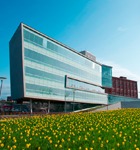The Scene
Prior to December 2009, Syracuse University’s computing equipment was housed in a 100-year-old building poorly suited to accommodate its increasingly complex system of wires, screens, and processors. So, the university built the Green Data Center, a state-of-the-art structure adjacent to an office building on the south campus. Located in an area that’s also home to more than 1,000 student apartments and three residence halls, the center was perfectly positioned to serve its principal users, who daily rely on what goes on inside the 12,000-square-foot nondescript building sheathed in metal siding. Its gray, nearly windowless exterior isn’t flashy, but the systems inside make it one of the greenest computer centers in operation today.
BY THE NUMBERS
500,000
The kWs of power the data center can provide to support its IT equipment
1,200
The tons of waste—approximately 60 truckloads—that was recycled during construction
99
The percent of all construction waste generated on site to date that has been diverted from landfills
The Setup
The project was a collaboration with IBM and the New York State Energy Research and Development Authority, who were interested in the facility as a demonstration project and together donated $7 million to support the construction of the building and the related research efforts. “One of the requirements of the Green Data Center was that it would be capable of operating on- or off-grid,” says Kevin Noble, Syracuse University’s chief engineer. “It is capable of doing a black start—we can start power generation without any power from the outside.” Finding the equipment to satisfy the university’s needs was one of the project’s biggest obstacles, and Noble also says the team “struggled with complying to standards that did not yet exist.”
The Strategy
As a data center, power reliability was critical, but Syracuse University was also interested in maximizing the structure’s power utilization effectiveness (PUE). It installed a tri-generation system, which uses natural gas-fired microturbines to make power and enables the Green Data Center to operate completely off-grid.
Here’s how it works: the thermal energy produced by the microturbines goes into two absorption chillers that then generate 300 tons of chilled water, which is then piped into the data center to cool the servers. These chillers can produce more chilled water than is needed by the data center, so the remainder is piped to the adjacent building for air-conditioning. In the winter months, industrial heat exchangers make hot water, capturing energy that otherwise would be wasted. This heat warms the nearby building and provides its domestic hot water. This trigeneration system, combined with the functionality of a recently developed Uninterrupted Power Supply system, is something Syracuse University believes hasn’t been done before.
The 400-volt DC power system is another unique feature of the data center. “The DC power is more efficient because it removes multiple conversion steps, and the power is supplied directly to the IT gear,” Noble says. “Some of the data center’s technology, or its application, was unproven for this use. The IBM z10 supercomputer is the first one operating on DC outside of IBM’s own research labs. We have attracted a great deal of interest from the industry as we prove those concepts.” Thanks to its groundbreaking technologies, the project is currently registered with the USGBC, and Syracuse University is anticipating LEED Silver certification.

